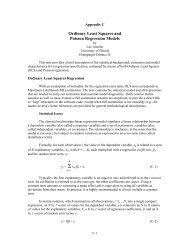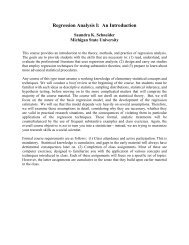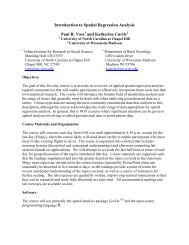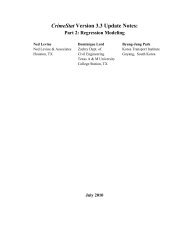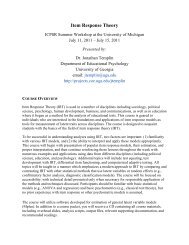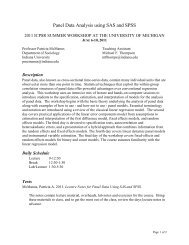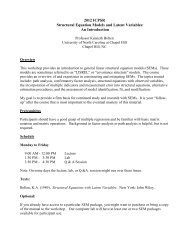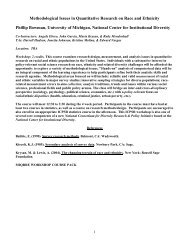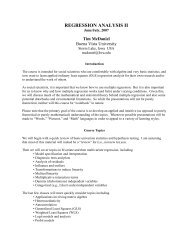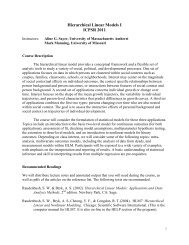introduction to stat.. - icpsr - University of Michigan
introduction to stat.. - icpsr - University of Michigan
introduction to stat.. - icpsr - University of Michigan
Create successful ePaper yourself
Turn your PDF publications into a flip-book with our unique Google optimized e-Paper software.
INTRODUCTION TO STATISTICS AND DATA ANALYSIS II<br />
July/August 2011<br />
Tim McDaniel<br />
Buena Vista <strong>University</strong> — S<strong>to</strong>rm Lake, Iowa USA — mcdaniel@bvu.edu<br />
Introduction<br />
This course is intended for social scientists who are comfortable with algebra and introduc<strong>to</strong>ry<br />
<strong>stat</strong>istics, and now want <strong>to</strong> learn introduc<strong>to</strong>ry applied ordinary least squares (OLS) bivariate and<br />
multiple regression analysis for their own research and/or <strong>to</strong> understand the work <strong>of</strong> others.<br />
As social scientists, it is important that we know how <strong>to</strong> use regression. But it is also important<br />
for us <strong>to</strong> know why and how regression works (and fails) under varying conditions. Given this,<br />
we will discuss much <strong>of</strong> the mathematical and <strong>stat</strong>istical theory behind bivariate and multiple<br />
regression and also some potential drawbacks and circumstantial limitations. So while the<br />
presentations will not be purely theoretical, neither will this course be “cookbook” in nature.<br />
The primary goal <strong>of</strong> the course is <strong>to</strong> develop an applied and intuitive (as opposed <strong>to</strong> purely<br />
theoretical or mathematical) understanding <strong>of</strong> the <strong>to</strong>pics. Whenever possible presentations will<br />
be in “Words,” “Picture,” and “Math” languages in order <strong>to</strong> appeal <strong>to</strong> a variety <strong>of</strong> learning styles.<br />
Course Topics<br />
We will begin with a quick review <strong>of</strong> basic univariate <strong>stat</strong>istics and hypothesis testing (“Stats I”).<br />
Then we will cover <strong>to</strong>pics in introduc<strong>to</strong>ry regression (bivariate and then multiple), including<br />
• Model specification and interpretation<br />
• Diagnostic tests and plots<br />
• Analysis <strong>of</strong> residuals and outliers<br />
• Transformations <strong>to</strong> induce linearity<br />
• Multicollinearity<br />
• Multiplicative interaction terms<br />
• Dummy (dicho<strong>to</strong>mous) independent variables<br />
Finally, as time permits and depending on the interest <strong>of</strong> the participants, we could also cover:<br />
• Au<strong>to</strong>correlation and Heteroscedasticity: An Introduction<br />
• Don‟t Do That! Some Things <strong>to</strong> Avoid in Social Science Research<br />
• “Intervalness” and “Collapsing Categories”: New Tests for Categorical X Variables<br />
• Regression: How the Math Works (Explaining OLS using Matrix Algebra)<br />
• Testing, Testing...: Some Advanced Statistical Tests in Regression Analysis<br />
• Weird Points and Pretty Pictures (Outliers, Influence/Leverage, and Diagnostic Graphs)<br />
• Welcome <strong>to</strong> Statistics! (Concepts, Pitfalls, Presentation Techniques, etc.)<br />
• When Y is a Dummy: An Introduction <strong>to</strong> Logistic Regression
Lecture Transcripts<br />
This course will utilize approximately 550 pages <strong>of</strong> Lecture Transcripts. These Lecture<br />
Transcripts are organized in three Booklets, and will serve as the sole required “textbook” for<br />
this course and as an information resource for you after the course ends. In addition, these<br />
Lecture Transcripts will also significantly reduce the amount <strong>of</strong> notes you have <strong>to</strong> write during<br />
class, which means you can concentrate more on learning and understanding the material itself.<br />
A detailed outline <strong>of</strong> the Lecture Transcripts is included in this syllabus. Each <strong>of</strong> the three<br />
Booklets <strong>of</strong> Lecture Transcripts will also have a Table <strong>of</strong> Contents with page numbers.<br />
Packets 1, 2, and 3 constitute “Booklet #1” <strong>of</strong> the Lecture Transcripts; this Booklet is furnished<br />
<strong>to</strong> all participants taking the course free <strong>of</strong> charge on the first day <strong>of</strong> class and will be used for<br />
the first week or so <strong>of</strong> the course. Near the end <strong>of</strong> the course Packet 12 will be furnished <strong>to</strong> you<br />
free <strong>of</strong> charge. Booklet #2 and Booklet #3 (i.e., Packets 4 through 11) are available for you <strong>to</strong><br />
purchase at the Pho<strong>to</strong>duplicating Office in Room 160 in the basement <strong>of</strong> the ISR building. The<br />
<strong>to</strong>tal cost should be approximately $25.00; further details will be shared in the first class.<br />
I urge you <strong>to</strong> purchase this year’s edition <strong>of</strong> the Lecture Transcripts, as opposed <strong>to</strong> using an<br />
earlier edition; I am constantly making substantive additions, deletions, and changes each year.<br />
Although these Lecture Transcripts are detailed, comprehensive, and self-contained, it is still<br />
advisable for you <strong>to</strong> study the relevant Packets before and (especially!) after each class, ask<br />
questions during class, and talk <strong>to</strong> either me or a Teaching Assistant outside <strong>of</strong> class if you are <strong>to</strong><br />
maximize your learning and other benefits from this course. The Lecture Transcripts contain<br />
several algebraic derivations and pro<strong>of</strong>s; we will not be taking class time <strong>to</strong> work through most<br />
<strong>of</strong> them, but instead they are provided for your information and inspection outside <strong>of</strong> class.<br />
Textbooks and Other Readings<br />
There is no required textbook. Later in this syllabus I provide you with information about<br />
several optional supplemental readings from various textbooks and journals, including which<br />
readings are appropriate for each <strong>of</strong> the twelve Packets (organized in<strong>to</strong> three Booklets...) <strong>of</strong> the<br />
required Lecture Transcripts. See the beginning <strong>of</strong> the “Some Suggested Readings” section for a<br />
discussion <strong>of</strong> the four textbooks (each a different style...) included in these optional readings.<br />
I do not think that any one <strong>of</strong> these four textbooks is significantly better than the others; instead,<br />
the one(s) that you might find best will depend upon a number <strong>of</strong> personal fac<strong>to</strong>rs, including<br />
your particular learning style. Therefore, instead <strong>of</strong> just picking one textbook, I have designed<br />
the course so that you can experiment and pick-and-choose which style <strong>of</strong> learning and<br />
(therefore) textbook(s) you prefer. Of course, you may decide <strong>to</strong> read and study (and maybe<br />
purchase) none, one, two, three, or even all four <strong>of</strong> these textbooks; again, that is entirely up <strong>to</strong><br />
you. See the alphabetized list <strong>of</strong> “Some Suggested Readings” near the end <strong>of</strong> this syllabus for<br />
the textbook readings corresponding <strong>to</strong> each Lecture Transcript Packet. Finally, other textbooks<br />
are also appropriate for this course; see me if you have any questions about this.
At the end <strong>of</strong> this syllabus you will find a bibliography for the textbooks and all <strong>of</strong> the other<br />
readings. I have included quite a few <strong>of</strong> the Sage <strong>University</strong> Paper Series on Quantitative<br />
Applications in the Social Sciences “Little Green Book” monographs; I like these a lot.... You<br />
may notice that some (though certainly not all) <strong>of</strong> the other readings are from political science<br />
books and journals; however, this is not a cause for either rejoicing or concern since they deal<br />
with methodological <strong>to</strong>pics that are easily and broadly generalizable across other social science<br />
disciplines (I would not have selected them otherwise!). I have also been careful <strong>to</strong> select<br />
readings and substantive examples from other areas and journals (e.g., criminal justice,<br />
economics, law, sociology, and social science in general). All materials listed in the<br />
bibliography are available at the Summer Program‟s Library. In addition, all textbooks and<br />
monographs should be available for purchase... but before you actually buy anything I strongly<br />
suggest you first “check it out” (in more ways than one...) from the Summer Program Library.<br />
Classes, Labs, Assignments, S<strong>of</strong>tware, and Matrix Algebra<br />
During the first two classes we will have a review <strong>of</strong> basic <strong>stat</strong>istics; after that, we will begin our<br />
consideration <strong>of</strong> Ordinary Least Squares regression models.<br />
Your grade will be determined by your performance on four data analysis Assignments. For each<br />
<strong>of</strong> these Assignments you will use SPSS as a <strong>to</strong>ol <strong>to</strong> generate output; then your substantive task<br />
will be <strong>to</strong> interpret, explain, and evaluate that output. It is important <strong>to</strong> note that this is a course<br />
on introduc<strong>to</strong>ry Regression Analysis, NOT on computer or s<strong>of</strong>tware usage. So do not worry if<br />
you are unfamiliar with SPSS; it is very quick and easy <strong>to</strong> learn and <strong>to</strong> use (which is why we use<br />
it in this course!). We will examine output, and discuss how it was generated, in class.<br />
Each participant will be assigned <strong>to</strong> a “Computer Usage Lab.” Each Computer Usage Lab<br />
session will be held in one <strong>of</strong> the computer labs in the Helen Newberry building and led by one<br />
<strong>of</strong> the Teaching Assistants. NOTE: It will be very important for you <strong>to</strong> attend these sessions!<br />
Accessing and using the SPSS data files for the homework will be covered in the Computer<br />
Usage Lab sessions. Do not be concerned if you will eventually (or currently do) use some<br />
s<strong>of</strong>tware other than SPSS in your own work; never forget that our goal here is <strong>to</strong> “learn<br />
introduc<strong>to</strong>ry Regression Analysis,” not <strong>to</strong> “learn a particular brand <strong>of</strong> computer s<strong>of</strong>tware usage.”<br />
There are computer counselors available <strong>to</strong> aid you in using the computers and SPSS <strong>to</strong> generate<br />
the output that you will analyze in your Assignments. The data files for the homework, as well<br />
as for most <strong>of</strong> the in-class examples, are available on the Summer Program‟s computer server. I<br />
will distribute a “Tu<strong>to</strong>rial and Answer Key” for each Assignment immediately after it is due;<br />
each <strong>of</strong> these will provide you with yet another excellent learning opportunity. IMPORTANT:<br />
You should attend the ICPSR Summer Program Lecture Series “Introduction <strong>to</strong> Computing” if<br />
you are not already extremely comfortable with basic computer operations and SPSS.<br />
We will not be using matrix algebra. While you are welcome <strong>to</strong> use any s<strong>of</strong>tware package <strong>to</strong><br />
complete the assignments, the course (including the TAs and the instruc<strong>to</strong>r) will not use, or<br />
support, any computer s<strong>of</strong>tware package other than SPSS.
Learning and the Course’s Teaching Assistants<br />
Remember, the primary purpose <strong>of</strong> the class meetings, Computer Usage Lab sessions, Lecture<br />
Transcripts, and Assignments is <strong>to</strong> help you learn this material and be successfully introduced <strong>to</strong><br />
regression models and analysis.<br />
You are not in this alone. Studying and learning with your fellow participants is probably a good<br />
(in fact, a very good!) idea for many <strong>of</strong> you, as is taking advantage <strong>of</strong> Office Hours opportunities<br />
involving myself and the Teaching Assistants for the course.<br />
Remember, attending the Computer Usage Lab sessions led by one <strong>of</strong> the Teaching Assistants is<br />
very important!<br />
The Teaching Assistants and I make every effort <strong>to</strong> be accessible <strong>to</strong> you. I encourage you <strong>to</strong><br />
attend our <strong>of</strong>fice hours, or <strong>to</strong> make an appointment if those hours do not work well within your<br />
schedule. Early in the course I will give you more information (e.g., an <strong>of</strong>fice hours schedule)<br />
regarding these matters.<br />
“Practical Matters” Involving Assignments and Grading<br />
Quantity. There are four Assignments that count <strong>to</strong>ward your course grade; they are worth 25,<br />
25, 30, and 20 points respectively.<br />
Purpose. The primary purpose <strong>of</strong> the Assignments is <strong>to</strong> further enhance your learning <strong>of</strong> the<br />
material. The Assignments also serve as the sole graded evaluation vehicle for those <strong>of</strong> you<br />
taking the course for a grade.<br />
Due Date. You will submit each Assignment at the beginning <strong>of</strong> class on the day it is due.<br />
Answer Keys. Everyone in the class will receive a “Tu<strong>to</strong>rial and Answer Key” for each<br />
Assignment immediately after it is due. Use each <strong>of</strong> them as an opportunity <strong>to</strong> learn!<br />
Calcula<strong>to</strong>r. You might need a basic calcula<strong>to</strong>r for some <strong>of</strong> the Assignment tasks.<br />
Details Matter. Your work will be graded on its quality, clarity, completeness, and accuracy, so:<br />
• You can either type your work or write it out by hand. In either case, make it very easy<br />
<strong>to</strong> read, follow, and understand (i.e., be organized and if you write then print neatly).<br />
• Clearly label which question you are answering (“A” or “B” or “C”..., etc.).<br />
• Show all <strong>of</strong> your work and supporting evidence, not just your bot<strong>to</strong>m-line answer.<br />
• Neatly write (print!) your name and the Assignment Number at the <strong>to</strong>p <strong>of</strong> the first page.<br />
• Also neatly write (print!) your name at the <strong>to</strong>p <strong>of</strong> each page.<br />
• Staple all <strong>of</strong> the submitted sheets <strong>of</strong> paper <strong>to</strong>gether, in the upper-left-hand corner.
No Late Submissions. Unless we have made specific and explicit arrangements beforehand, no<br />
Assignment submitted late will be accepted.<br />
Not “For Credit”? Not a Problem! If you are not taking the course “for credit” then you can still<br />
submit none, some, or all <strong>of</strong> the Assignments for grading; it is completely up <strong>to</strong> you. In order <strong>to</strong><br />
optimize your learning opportunities, any work you do decide <strong>to</strong> submit will be evaluated as if<br />
you were taking the course for credit; no problem at all...!<br />
Grading Templates. In order <strong>to</strong> facilitate more efficient and accurate grading by the course‟s<br />
Teaching Assistants, and also <strong>to</strong> enhance your understanding <strong>of</strong> the grading (e.g., partial credit)<br />
decisions and your <strong>to</strong>tal numerical grade, each Assignment will be returned along with a<br />
completed grading template form.<br />
Grade Appeals. If you ever have any questions about any <strong>of</strong> your grades (e.g., partial credit<br />
decisions) then you can see me (not a Teaching Assistant!) <strong>to</strong> discuss the situation, including<br />
possibly appealing a grading decision. However, here are a couple <strong>of</strong> relevant course policies:<br />
• You must wait at least 24 hours after receiving your grade. This “24 Hour Rule” gives<br />
you time <strong>to</strong> study and contemplate your work-product, your notes, the Lecture<br />
Transcripts, the Grading Template, and the “Tu<strong>to</strong>rial and Answer Key”... and <strong>to</strong> think<br />
about your work and the corresponding grading decision.<br />
• The maximum amount <strong>of</strong> time you have <strong>to</strong> appeal a grading decision is three class days<br />
after that Assignment is returned; after then no grading appeals will be considered.<br />
Exceptions <strong>to</strong> this course policy:<br />
• The “24 Hour Rule” is waived for Assignment #4.<br />
• All grading appeals must be made before 2:15 p.m. on the last day <strong>of</strong> the course.<br />
Working Together and Doing Your Own Work. I encourage you <strong>to</strong> work and learn with other<br />
participants on all learning activities in this course, including the Assignments. However, all <strong>of</strong><br />
the work on each Assignment you submit needs <strong>to</strong> be your work; i.e., you need <strong>to</strong> produce your<br />
own actual submitted work-product material. See me if you have any questions about this.<br />
Conclusion<br />
Remember, the learning objectives in this course encompass learning introduc<strong>to</strong>ry applied<br />
ordinary least squares (OLS) bivariate and multiple regression analysis for your own research<br />
and/or <strong>to</strong> understand the work <strong>of</strong> others.<br />
Learning the material in this course will require a substantial amount <strong>of</strong> effort on your part... but<br />
that is why you are here, and the pay<strong>of</strong>f will be well worth that effort.<br />
Let me know if the Teaching Assistants or I can be <strong>of</strong> any assistance <strong>to</strong> you in this endeavor.<br />
It is an honor <strong>to</strong> be your instruc<strong>to</strong>r for this course.
Course (and Lecture Transcript) Outline<br />
Packet I. Basic Statistics Review<br />
1 A. Summations and Sigma Notation<br />
B. Basic Statistics<br />
1. Mean<br />
2. Variance and Standard Deviation<br />
3. Probability<br />
4. Random Variables<br />
a. Continuous versus Discrete<br />
b. Nominal, Ordinal, and Interval<br />
5. Standardized Variables<br />
6. Expected Value<br />
7. Covariance, Correlation, and Causality<br />
8. Independence<br />
9. Normal Distribution: Notation, Skewness & Kur<strong>to</strong>sis, Areas<br />
10. Central Limit Theorem<br />
11. “Student‟s t” Distribution<br />
12. Hypothesis Testing<br />
13. Prob-Values (“p-Values”)<br />
14. Confidence Intervals<br />
15. Properties <strong>of</strong> Estima<strong>to</strong>rs<br />
———————————————————————————————————————<br />
Packet II. Supplement <strong>to</strong> Basic Statistics Review<br />
2 A. A Closer Look at Population and Sample Variances<br />
B. Hypothesis Testing: Summary, Flowchart, Pro<strong>to</strong>col, and p-Values<br />
C. Some Abuses and Misuses <strong>of</strong> Probability and Statistics<br />
D. Symbol Glossary<br />
———————————————————————————————————————<br />
Packet III. Bivariate Regression<br />
3 A. Notation<br />
B. Fitting a Line<br />
C. Ordinary Least Squares Assumptions<br />
D. Deriving the Sample Intercept and the Slope Coefficient Using Algebra<br />
E. Centered Variables<br />
F. The Estimated Slope Coefficient, “b”<br />
1. Variance and Confidence Interval<br />
2. Confidence Interval and Hypothesis Testing<br />
G. The Gauss-Markov Theorem<br />
H. Appendix: Deriving the Formulas for “a” and “b” Using Calculus<br />
———————————————————————————————————————
Packet I. Residuals<br />
4 1. Definition and Estimation<br />
2. True, Population “Error” as a Disturbance, or S<strong>to</strong>chastic Element<br />
J. Explained, Unexplained, and Total Deviations and Sums <strong>of</strong> Squares<br />
K. Goodness <strong>of</strong> Fit<br />
1. Coefficient <strong>of</strong> Determination (R-Squared)<br />
a. Correlations (Again...)<br />
b. Why the R-Squared Can Be Inappropriate and Misleading<br />
c. Perils <strong>of</strong> Maximizing R-Squared: A Monte Carlo Simulation<br />
2. Standard Error <strong>of</strong> Regression (SER)<br />
L. Standardized Variables and Beta Weights<br />
M. Reporting OLS Regression Results<br />
N. Regression Forced Through the Origin<br />
1. Definition, Illustrations, and Examples<br />
2. The Importance <strong>of</strong> Theoretical and Substantive Justifications<br />
O. Comparison <strong>of</strong> Centering, Standardizing, and Forcing Through the Origin<br />
P. Another Note on the Meaning and Interpretation <strong>of</strong> “a,” “b,” and Y-Hat<br />
Q. An Analogy: Means, Slopes, Standardization, Samples and Populations<br />
———————————————————————————————————————<br />
Packet R. Functional Transformations <strong>of</strong> Independent Variables<br />
5 1. The Need for Transformations<br />
2. The Regression is Still Linear<br />
3. The Natural Log and the Square Root Transformations<br />
4. The X-Squared Transformation<br />
5. Presenting Findings with Transformed Independent Variables<br />
———————————————————————————————————————<br />
Packet S. Interpolation, Predictive Intervals, and Extrapolation<br />
6 T. Some Simple Diagnostic Plots<br />
1. Y vs. X (and an Introduction <strong>to</strong> Outliers)<br />
2. Y vs. Y-Hat<br />
Assignments 3. Residual vs. X<br />
#1 and #2 4. Residual vs. Case Number<br />
Given<br />
5. Residual vs. Lagged Residual<br />
6. Residual vs. Y-Hat<br />
U. Simpson‟s Paradox (Aggregation Bias)<br />
V. Generation and Interpretation <strong>of</strong> Computer Output Using Real Data<br />
1. Setting-Up the Substantive Example<br />
2. Generating and Analyzing the Output<br />
W. The Usefulness <strong>of</strong> Simple Scatter Plots: An Illustration<br />
X. R-Squared, “b,” and SER: A Monte Carlo Simulation<br />
———————————————————————————————————————
Packet IV. Introduction <strong>to</strong> Multiple Regression<br />
7 A. Limits <strong>of</strong> Bivariate Regression<br />
B. Trivariate Regression<br />
1. Visualization<br />
2. The Residual Term<br />
a. Definition<br />
b. The SER and Degrees <strong>of</strong> Freedom<br />
3. The (Two) Estimated Slope Coefficients<br />
a. Partial Effects Equations, Models, and Venn Diagrams<br />
b. Computing the Two Slope Coefficients<br />
c. Variance and Confidence Intervals<br />
d. Meaning and Interpretation<br />
4. Holding One Variable “Constant”: What‟s That All About?<br />
5. The Impact on OLS Assumptions<br />
C. Multiple Regression: The General OLS Model<br />
1. The Slope Coefficient<br />
a. Partial Effects Equations<br />
b. Computing the Slope Coefficients<br />
c. OLS Assumptions and the Gauss-Markov Theorem<br />
d. Meaning and Interpretation<br />
e. Variance and Confidence Intervals<br />
2. The Residual Term<br />
a. Definition<br />
b. The SER and Degrees <strong>of</strong> Freedom<br />
3. Degrees <strong>of</strong> Freedom: From One <strong>to</strong> Many Variables<br />
———————————————————————————————————————<br />
Packet<br />
4. Summary and Review <strong>of</strong> Partial Effects and the Interpretation <strong>of</strong> “b”<br />
8 5. Summary and Review <strong>of</strong> T-Stats, Prob-Values, and Hypothesis Tests<br />
6. Units <strong>of</strong> the SER and Comparing SER‟s Across Equations<br />
7. R-Squared and Adjusted R-Squared<br />
a. Review <strong>of</strong> the R-Squared Statistic<br />
b. Inappropriateness <strong>of</strong> Comparing R-Squareds across Models<br />
c. R-Squared and Functional Transformations<br />
d. Multiple Independent Variables and the Effect on R-Squared<br />
e. Computing and Interpreting the Adjusted R-Squared Value<br />
8. Interactions<br />
a. Description and Analogy <strong>to</strong> Functional Transformations<br />
b. Models with an Interaction <strong>of</strong> Two Dummy Variables<br />
c. Models with an Interaction <strong>of</strong> a Dummy and a Continuous Variable<br />
d. Interpreting Models with Interactions (Values, Algebra, Graphs)<br />
e. Model Specification (e.g., “Can I Exclude a Stand-Alone Term?”)<br />
———————————————————————————————————————
Packet 9. Multicollinearity and Multicollinearity Diagnostics<br />
9 a. Perfect Multicollinearity: An Example<br />
b. Auxiliary R-Squared, Tolerance, and Variance Inflation Fac<strong>to</strong>r<br />
c. Discussing Multicollinearity Using Venn Diagrams<br />
d. Consequences, Including Possible “Backdoor Bias”<br />
e. When <strong>to</strong> Suspect Multicollinearity Problems<br />
f. How NOT <strong>to</strong> Diagnose Multicollinearity: Bivariate Correlations<br />
g. Possible Remedies<br />
h. A Statistics, Estimation, and Information (Not a Theory!) Problem<br />
i. Narrowing Down the Source <strong>of</strong> the Multicollinearity<br />
10. Dummy and Categorical Independent Variables<br />
a. Definition and Interpretation<br />
b. The Importance <strong>of</strong> “Intervalness” for Independent Variables<br />
c. Replacing a Categorical Independent Variable with Dummies<br />
i. Implementation and Interpretation<br />
ii. Excluding one Dummy from the Model<br />
d. Graphing Models with Dummy Variables (and Interactions)<br />
e. Comparison: “Regression Forced Through Origin” <strong>to</strong> “Having X<br />
in an Interaction, but Not as a Stand-Alone, Term”<br />
f. Interpretation <strong>of</strong> Category Dummies and “Jumps”<br />
———————————————————————————————————————<br />
Packet<br />
11. Functional Transformations<br />
10 a. Things <strong>to</strong> Consider Regarding Transforming Y<br />
b. Log Transformations and Constant Elasticity Models<br />
c. Conditional Impacts and Slopes in Models with Interaction Terms<br />
d. Models with an X-Squared Term (Including Threshold Models)<br />
e. The Bend Rule<br />
12. Model Specification<br />
a. Review <strong>of</strong> Types <strong>of</strong> Specification Error<br />
b. Omitting Relevant Variables: Derivation and Consequences<br />
c. Including Irrelevant Variables: Consequences<br />
d. Variable Selection<br />
e. Perils <strong>of</strong> Stepwise Regression<br />
f. An Alternative <strong>to</strong> Standardization for Interval-Level Discrete X‟s<br />
13. Missing Data<br />
a. Data Missing at Random: Dependent and Independent Variables<br />
b. “Solutions” and Their Potential Problems<br />
i. Casewise (Listwise) Deletion<br />
ii. Pairwise Deletion<br />
iii. Mean and Conditional Mean Substitution<br />
iv. Other Methods (e.g., Pr<strong>of</strong>ile Models)<br />
14. Measurement Errors: In Y and in an X<br />
15. Partial Effects Plots and Linearity in Multiple Regression Models<br />
———————————————————————————————————————
Packet 16. Summary: The Effects <strong>of</strong> Multicollinearity and Specification Errors<br />
11 on Slope Coefficient Estimation and Hypothesis Testing<br />
a. Type I and Type II Errors<br />
Assignments<br />
b. Flowcharts: Review <strong>of</strong> the Logic <strong>of</strong> Hypothesis Testing<br />
#3 and #4 c. Essay: Hypothesis Testing and American Criminal Trials<br />
Given<br />
17. Review: Category Dummy Variables<br />
18. Review: Models with Continuous, Dummy, and Interaction Terms<br />
19. Review: Diagnostic Partial Plots<br />
20. Another Look at Outliers: What They Are and Why They Matter<br />
21. Flowchart: Tim McDaniel‟s Guide <strong>to</strong> Dealing with Outliers<br />
22. Multiple Regression: A Computer Example Using ANES Data<br />
a. Setting-Up the Example (American National Election Study)<br />
b. Generation and Interpretation <strong>of</strong> Computer Output<br />
i. Control Variables, Multicollinearity, and Diagnostic Plots<br />
ii. Categorical Independent Variables, Intervalness, and “Jumps”<br />
c. Review, Analysis, and Wrap-Up <strong>of</strong> Computer Example<br />
23. Sub-Group Differences: “Dummy*Continuous” Interaction Terms<br />
———————————————————————————————————————<br />
Packet V. Analysis <strong>of</strong> Variance and the F-Test<br />
12 A. The F Distribution<br />
B. Total, Regression, and Error Sum <strong>of</strong> Squares... and the ANOVA Table<br />
C. The F-Statistic and the F-Test<br />
1. A Test Involving All <strong>of</strong> the Regression Coefficients<br />
2. The Special Case When the F-Test and Student‟s t-Test Are Identical<br />
D. Analysis and Demonstrations Using Computer Output<br />
1. Interpreting the F-Test: A Randomly Generated Variables Illustration<br />
2. Another Look at R-Squared, Adjusted R-Squared, and SER<br />
VI. Chart: Some Potential Problems When Using OLS Regression Models<br />
VII. Final Remarks<br />
A. More than One Equation: Simultaneous Equations Models<br />
B. Additional Topics for Further Study<br />
C. The Importance <strong>of</strong> Parsimony and Presentation<br />
D. The Dangers <strong>of</strong> Over-Reliance on Statistical Procedures<br />
———————————————————————————————————————<br />
Also: We will cover other <strong>to</strong>pics related <strong>to</strong> introduc<strong>to</strong>ry regression analysis as time permits and<br />
depending on the interest <strong>of</strong> the participants. See the bot<strong>to</strong>m <strong>of</strong> Page 1 for some possible<br />
<strong>to</strong>pics. We will discuss the more as we approach the end <strong>of</strong> the course.<br />
═══════════════════════════════════════════════════════
Some Suggested Readings<br />
As mentioned earlier, the Lecture Transcripts that I wrote and we use in each class serve as the<br />
functional equivalence <strong>of</strong> a textbook for this course. I advise you <strong>to</strong> use the outline as a guide for<br />
these Lecture Transcripts (along with the Table <strong>of</strong> Contents provided in each Booklet).<br />
The additional readings in this section <strong>of</strong> the syllabus (details <strong>of</strong> which can be found in the<br />
Bibliography section that immediately follows) are <strong>to</strong>tally optional for you.<br />
Several <strong>of</strong> these readings are from the following four “traditional” textbooks, each <strong>of</strong> which I<br />
like a lot. While there are lots <strong>of</strong> similarities between them, I think that each takes a somewhat<br />
different (though at times only subtly different...) pedagogical approach.<br />
• Gujarati takes more <strong>of</strong> a “Math Language” (but neither advanced nor solely) approach.<br />
• Hamil<strong>to</strong>n takes more <strong>of</strong> a “Picture Language” (lots <strong>of</strong> graphics, etc.) approach.<br />
• Kennedy takes more <strong>of</strong> an “English Language” (narrative explanations) approach.<br />
• Wooldridge takes more <strong>of</strong> a “Combined” (and accessible and comprehensive) approach.<br />
You will also notice several “little green books” from the Sage Series on Quantitative<br />
Applications in the Social Sciences. Both the more recent ones and the older “classics” are very<br />
useful as learning vehicles.<br />
Finally, I have included several articles from a number <strong>of</strong> journals across several academic<br />
disciplines—again, some that are older “classics” and some others that are more recent.<br />
So... here are the suggested optional readings for each Packet <strong>of</strong> the Lecture Transcripts:<br />
Lecture Packet Suggested Optional Readings (In Alphabetical Order)<br />
Packets 1 & 2<br />
Baumgartner, Breunig, et al. (especially pages 606-613)<br />
Gujarati and Porter: Intro; Sections 5.5-5.8, 6A.2; Appendix A<br />
Hamil<strong>to</strong>n: Pages 289-296<br />
Kennedy: Sections 2.5-2.8<br />
Mohr<br />
Wooldridge: Appendices A.1-A.4, B, C.2-C.6<br />
Packet 3<br />
Gujarati and Porter: Chapter 1; Sections 2.1, 2.2., 2.6, 2.7, 3.1-3.4,<br />
3A.1-3A.7, 4.1-4.3, 5.1-5.3<br />
Hamil<strong>to</strong>n: Pages 29-34, 42-49, 296-297<br />
Kennedy: Chapter 3; Sections 1.1, 1.4, 2.1-2.3, 2.11<br />
Lewis-Beck: Pages 9-20, 26-38<br />
Schroeder, Sjoquist, and Stephan: Pages 11-23, 81-82<br />
Wooldridge: Chapter 1; Sections 2.1-2.5
Lecture Packet Suggested Optional Readings (In Alphabetical Order)<br />
Packet 4<br />
Achen (1982): Pages 73-77<br />
Achen (1991)<br />
Gujarati and Porter: Sects. 2.4, 2.5, 3.5, 3.8, 5.4, 5.11, 6.1-6.3, 6A.1<br />
Hamil<strong>to</strong>n: Pages 37-41, 49-51, 124-125<br />
Kennedy: Sections 1.2, 2.4, 2.10; Pages 109-110<br />
King (1986)<br />
King (1991)<br />
Lewis-Beck: Pages 20-25<br />
Lewis-Beck and Skalaban<br />
Schroeder, Sjoquist, and Stephan: Pages 23-29, 31-32<br />
Wooldridge: Section 2.6<br />
Packet 5<br />
Packet 6<br />
Packet 7<br />
Packet 8<br />
Gujarati and Porter: Sections 2.3, 6A.3; Pages 164-166<br />
Hamil<strong>to</strong>n: Pages 53-58, 148<br />
Goertzel<br />
Gujarati and Porter: Sections 3.6, 3.7, 5.10<br />
Hamil<strong>to</strong>n: Pages 34-37, 41-42, 51-53, 58-59<br />
Lewis-Beck: Pages 38-47<br />
Achen (1982): Pages 7-51<br />
Asher: Pages 237-248<br />
Berry: Pages 1-24, 81-83<br />
Berry and Feldman: Pages 9-15<br />
Fox: Pages 3-9<br />
Gujarati and Porter: Sections 7.1-7.4, 7.6, 8.1-8.3, 8.8<br />
Hamil<strong>to</strong>n: Pages 65-72, 109-113<br />
Kennedy: Section 1.3<br />
Lewis-Beck: Pages 47-52, 53-54<br />
Schroeder, Sjoquist, and Stephan: Pages 29-31<br />
Wooldridge: Chapters 3, 5; Sections 4.1-4.3<br />
Berry: Pages 24-27<br />
Berry and Feldman: Pages 15-16<br />
Brambor, Clark, and Golder<br />
Braumoeller<br />
Davenport, Armstrong, and Lichbach<br />
Friedrich<br />
Gujarati and Porter: Sections 7.5, 7.8, 9.6<br />
Hamil<strong>to</strong>n: Pages 77-80, 84-85<br />
Kennedy: Section 5.5<br />
Lewis-Beck: Pages 52-53, 54-56<br />
Schroeder, Sjoquist, and Stephan: Pages 32-51, 54-56, 58-59<br />
Wooldridge: Section 6.3
Lecture Packet Suggested Optional Readings (In Alphabetical Order)<br />
Packet 9<br />
Asher: Pages 248-250<br />
Berry: Pages 45-47<br />
Berry and Feldman: Pages 37-50, 64-70<br />
Fox: Pages 10-21<br />
Gujarati and Porter: Chapter 10; Sections 8.5, 9.1-9.4<br />
Hamil<strong>to</strong>n: Pages 82, 85-92, 133-136<br />
Hardy: Pages 1-21, 29-48<br />
Kennedy: Chapter 12; Sections 15.1-15.4<br />
Lewis-Beck: Pages 58-63, 66-71<br />
Schroeder, Sjoquist, and Stephan: Pages 56-58, 71-72<br />
Wooldridge: Sections 7.1-7.3, 7.6; Pages 238-243<br />
Packet 10<br />
Packet 11<br />
Packet 12<br />
Achen (1982): Pages 51-73; 77-79<br />
Asher: Pages 250-255<br />
Baumgartner, Breunig, et al. (especially pages 613-615)<br />
Berry: Pages 27-41, 60-66<br />
Berry and Feldman: Pages 18-37, 71-72<br />
Clarke<br />
Fox: Pages 53-61<br />
Gujarati and Porter: Sections 6.4, 6.5, 6.8, 6.9, 7.7, 7.9, 7.10,<br />
13.1-13.3, 13.5, 13A.1-13A.3; Pages 499-500<br />
Halvorsen and Palmquist<br />
Hamil<strong>to</strong>n: Pages 72-77, 82-84, 148-153, 163-167, 173-174<br />
Kennedy: Sections 5.1-5.4, 6.1-6.3; Pages 49 (the first point), 111<br />
Lewis-Beck: Pages 56-58, 63-66<br />
Schroeder, Sjoquist, and Stephan: Pages 53, 59-61, 65-71<br />
Wooldridge: Sections 6.1, 6.2, 9.4; Pages 300-303, 322<br />
Achen (2002)<br />
Achen (2005)<br />
Berry: Pages 41-45, 49-60<br />
Eisenberg and Wells<br />
Hamil<strong>to</strong>n: Pages 158-163<br />
Lewis-Beck: Pages 71-73<br />
Schroeder, Sjoquist, and Stephan: Pages 63-65<br />
Wooldridge: Sections 4.6, 6.4<br />
Berry and Feldman: Pages 17-18<br />
Gujarati and Porter: Sections 5.9, 8.4<br />
Hamil<strong>to</strong>n: Pages 92-101<br />
Mock and Weisberg<br />
Schroeder, Sjoquist, and Stephan: Pages 51-52<br />
Wooldridge: Pages 152-153
Bibliography<br />
Achen, C. Interpreting and Using Regression. Sage <strong>University</strong> Paper Series on Quantitative<br />
Applications in the Social Sciences, #029, 1982.<br />
Achen, C. “What Does „Explained Variance‟ Explain?: Reply.” In Political Analysis, Volume 2.<br />
The <strong>University</strong> <strong>of</strong> <strong>Michigan</strong> Press, 1991. Pages 173-184.<br />
Achen, C. “Toward a New Political Methodology: Micr<strong>of</strong>oundations and ART.” In Annual<br />
Review <strong>of</strong> Political Science 5 (June 2002). Pages 423-450.<br />
Achen, C. “Let‟s Put Garbage-Can Regressions and Garbage-Can Probits Where They Belong.”<br />
Conflict Management and Peace Science 22:4 (January 2005). Pages 327-339.<br />
Asher, H. “Regression Analysis.” In Asher, H., Weisberg, H., Kessel, J., and Shively, W.,<br />
Theory-Building and Data Analysis in the Social Sciences. <strong>University</strong> <strong>of</strong> Tennessee<br />
Press, 1984. Pages 237-261.<br />
Baumgartner, F., Breunig, C., Green-Pedersen, C., Jones, B., Mortensen, P., Nuytemans, M., and<br />
Walgrave, S. “Punctuated Equilibrium in Comparative Perspective.” American Journal<br />
<strong>of</strong> Political Science 53(3) (July 2009). Pages 603-620.<br />
Berry, W. Understanding Regression Assumptions. Sage <strong>University</strong> Paper Series on<br />
Quantitative Applications in the Social Sciences, #092, 1993.<br />
Berry, W. and Feldman, S. Multiple Regression in Practice. Sage <strong>University</strong> Paper Series on<br />
Quantitative Applications in the Social Sciences, #050, 1985.<br />
Brambor, T., Clark, W., and Golder, M. “Understanding Interaction Models: Improving<br />
Empirical Analysis.” Political Analysis 14(1) (2006). Pages 63-82.<br />
Braumoeller, B. “Hypothesis Testing and Multiplicative Interaction Terms.” International<br />
Organization 58:4 (Fall 2004). Pages 807-820.<br />
Clarke, K. “The Phan<strong>to</strong>m Menace: Omitted Variable Bias in Econometric Research.” Conflict<br />
Management and Peace Science 22(4) (September 2005). Pages 341-352.<br />
Davenport, C., Armstrong, D., and Lichbach, M. “Conflict Escalation and the Origins <strong>of</strong> Civil<br />
War.” Paper presented at the annual meeting <strong>of</strong> the Midwest Political Science<br />
Association, Chicago, Illinois, USA. April 7, 2005.<br />
Eisenberg, T. and Wells, M. “The Significant Association Between Punitive and Compensa<strong>to</strong>ry<br />
Damages in Blockbuster Cases: A Methodological Primer.” Journal <strong>of</strong> Empirical Legal<br />
Studies 3:1 (March 2006). Pages 175-195.
Fox, J. Regression Diagnostics. Sage <strong>University</strong> Paper Series on Quantitative Applications in<br />
the Social Sciences, #079, 1991.<br />
Friedrich, R. “In Defense <strong>of</strong> Multiplicative Terms in Multiple Regression Equations.” American<br />
Journal <strong>of</strong> Political Science 26 (November 1982). Pages 797-837.<br />
Goertzel, T. “Capital Punishment and Homicide: Sociological Realities and Econometric<br />
Illusions.” Skeptical Inquirer 28:4 (July/August 2004). Pages 23-27.<br />
Gujarati, D. and Porter, D. Basic Econometrics, Fifth Edition. McGraw-Hill, 2009.<br />
Halvorsen, R., and Palmquist, R. “The Interpretation <strong>of</strong> Dummy Variables in Semilogarithmic<br />
Equations.” The American Economic Review 70:3 (June 1980). Pages 474-475.<br />
Hamil<strong>to</strong>n, L. Regression with Graphics: A Second Course in Applied Statistics. Duxbury, 1992.<br />
(Note: This is the same as the edition published by Brooks Cole in 1999.)<br />
Hardy, M. Regression with Dummy Variables. Sage <strong>University</strong> Paper Series on Quantitative<br />
Applications in the Social Sciences, #093, 1993.<br />
Kennedy, P. A Guide <strong>to</strong> Econometrics, Sixth Edition. Blackwell Publishing, 2008.<br />
King, G. “How Not <strong>to</strong> Lie With Statistics: Avoiding Common Mistakes in Quantitative Political<br />
Science.” American Journal <strong>of</strong> Political Science 30 (August 1986). Pages 666-687.<br />
King, G. “S<strong>to</strong>chastic Variation: A Comment on Lewis-Beck and Skalaban‟s „The R-Squared‟.”<br />
In Political Analysis, Volume 2. The <strong>University</strong> <strong>of</strong> <strong>Michigan</strong> Press, 1991. Pages 185-200.<br />
Lewis-Beck, M. Applied Regression: An Introduction. Sage <strong>University</strong> Paper Series on<br />
Quantitative Applications in the Social Sciences, #022, 1980.<br />
Lewis-Beck, M. and Skalaban, A. “The R-Squared: Some Straight Talk.” In Political Analysis,<br />
Volume 2. Ann Arbor: The <strong>University</strong> <strong>of</strong> <strong>Michigan</strong> Press, 1991. Pages 153-171.<br />
Mock, C. and Weisberg, H. “Political Innumeracy: Encounters with Coincidence, Improbability,<br />
and Chance.” American Journal <strong>of</strong> Political Science 36 (November 1992). Pages<br />
1023-1046.<br />
Mohr, L. Understanding Significance Testing. Sage <strong>University</strong> Paper Series on Quantitative<br />
Applications in the Social Sciences, #073, 1990.<br />
Schroeder, L., Sjoquist, D., and Stephan, P. Understanding Regression Analysis. Sage<br />
<strong>University</strong> Paper Series on Quantitative Applications in the Social Sciences, #057, 1986.<br />
Wooldridge, J. Introduc<strong>to</strong>ry Econometrics: A Modern Approach, Fourth Edition.<br />
South-Western, 2009.



